 W
WQuilting is the term given to the process of joining a minimum of three layers of fabric together either through stitching manually by hand using a needle and thread, or mechanically with a sewing machine or specialised longarm quilting system. An array of stitches is passed through all layers of the fabric to create a three dimensional padded surface. The three layers are typically referred to as the top fabric or quilt top, batting or insulating material and the backing.
 W
WChinese patchwork is a traditional form of Chinese needlework which has been widely circulated in Chinese folk arts. In China, patchwork has been used for millennia.
 W
WCommon Threads: Stories from the Quilt is a 1989 American documentary film that tells the story of the NAMES Project AIDS Memorial Quilt. Narrated by Dustin Hoffman with a musical score written and performed by Bobby McFerrin, the film focuses on several people who are represented by panels in the Quilt, combining personal reminiscences with archive footage of the subjects, along with footage of various politicians, health professionals and other people with AIDS. Each section of the film is punctuated with statistics detailing the number of Americans diagnosed with and dead of AIDS through the early years of the epidemic. The film ends with the first display of the complete Quilt at the National Mall in Washington, D.C. during the 1987 Second National March on Washington for Lesbian and Gay Rights.
 W
WThe conservation and restoration of quilts refers to the processes involved in maintaining the integrity of quilts and/or restoring them to an acceptable standard so that they may be preserved for future generations. Quilts have been produced for centuries, as utilitarian blankets, decorations, family heirlooms, and now treasured museum collections objects. Quilts are three-layered textile pieces with a decorated top, a back, and a filler in the middle. The composite nature of these objects creates an interesting challenge for their conservation, as the separate layers can be made of different textile materials, multiple colors, and therefore, varying degrees of wear, tear, and damage.
 W
WCorded quilting is a decorative quilting technique popular from the late 17th through the early 19th centuries. In corded quilting, a fine fabric, sometimes colored silk but more often white linen or cotton, is backed with a loosely woven fabric. Floral or other motifs are outlined in parallel rows of running stitches or backstitches to form channels, and soft cotton cord is inserted through the backing fabric using a blunt needle and drawn along the quilted channels to produce a raised effect. Tiny quilting stitches in closely spaced rows fill the motifs and provide contrast to the corded outlines.
 W
WThe term "crazy quilting" is often used to refer to the textile art of crazy patchwork and is sometimes used interchangeably with that term. Crazy quilting does not actually refer to a specific kind of quilting, but a specific kind of patchwork lacking repeating motifs and with the seams and patches heavily embellished. A crazy quilt rarely has the internal layer of batting that is part of what defines quilting as a textile technique.
 W
WEnglish paper piecing is a method of patchwork where fabric is wrapped around fabric shapes made of thin paper cardboard or heavy paper. Once the shapes are wrapped and ready, the sewer will hand sew the shapes together one at a time until the shapes become an intricate design. The paper or cardboard is removed once the shape has been sewn to another shape on all sides. This is an art for those who like to sew by hand.
 W
WFons & Porter's Love of Quilting is a magazine and television program focusing on the art and technique of piecing and quilting quilts. The show was hosted by Liz Porter and Marianne Fons. Both have retired and occasionally make guest appearances on the show. Porter left first and Mary Fons, Marianne's daughter, began to co-host the show with her mother. Gradually, Mary began to host alone with a guest to show a new technique as often as with Marianne. As of 2016, Marianne and Mary do the tips segment, but most shows include either Mary with a guest or David Lose with a guest. The magazine Love of Quilting was first published in 1999 and has been on TV since 2003. Each episode consists of a technique lesson, usually focusing on a single block for a finished quilt, and a tips section of viewer-submitted tips.
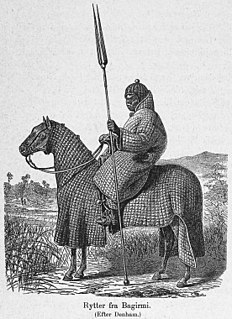 W
WA gambeson is a padded defensive jacket, worn as armor separately, or combined with mail or plate armor. Gambesons were produced with a sewing technique called quilting. They were usually constructed of linen or wool; the stuffing varied, and could be for example scrap cloth or horse hair. During the 14th century, illustrations usually show buttons or laces up the front.
 W
WA Hawaiian quilt is a distinctive quilting style of the Hawaiian Islands that uses large radially symmetric applique patterns. Motifs often work stylized botanical designs in bold colors on a white background.
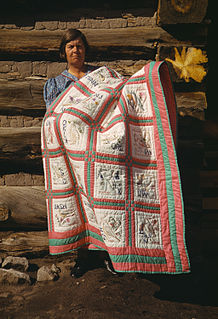 W
WThe history of quilting, the stitching together of layers of padding and fabric, may date back as far as 3400 BCE. For much of its history, quilting was primarily a practical technique to provide physical protection and insulation. However, decorative elements were often also present, and many quilts are now primarily art pieces.
 W
WKogin-zashi (こぎん刺し) is one of the techniques of sashiko, or traditional Japanese decorative reinforcement stitching, that originated in the part of present-day Aomori Prefecture controlled by the Tsugaru clan during the Edo period (1603-1867). It is also referred to as sashi-kogin.
 W
WLongarm quilting is the process by which a longarm sewing machine is used to sew together a quilt top, quilt batting and quilt backing into a finished quilt. The longarm sewing machine frame typically ranges from 10 feet to 14 feet in length. A complete longarming system typically consists of an industrial length sewing machine head a 10 to 14-foot frame, a table with a layer of plastic under which is placed a pantograph, and several rollers on which the fabric layers and batting are attached.
 W
WMachine quilting is quilting made using a sewing machine to stitch in rows or patterns using select techniques to stitch through layers of fabric and batting in the manner of old-style hand-quilting. Some machines even replicate hand stitching, for example Sashiko or running stitch quilting.
 W
WNakshi kantha, a type of embroidered quilt, is a centuries-old Bengali art tradition of the Bengal region, notable in Bangladesh and Indian states of West Bengal, Tripura and part of Assam. The basic material used is thread and old cloth. Nakshi kanthas are made throughout Bangladesh, but the greater Mymensingh, Jamalpur, Bogra, Rajshahi, Faridpur and Jessore,Chitagong areas are most famous for this craft.
 W
WA patchwork quilt is a quilt in which the top layer may consist of pieces of fabric sewn together to form a design. Originally, this was to make full use of leftover scraps of fabric, but now fabric is often bought specially for a specific design. Fabrics are now often sold in quarter meters. A "fat quarter" is one square meter folded into four and cut along the folds, thus giving a relatively square piece of fabric 50 cm on a side, as opposed to buying a quarter of a meter off the roll, resulting in a long thin piece that is only 25 cm wide.
 W
WPossum-skin cloaks were a form of clothing worn by Aboriginal people in the south-east of Australia – present-day Victoria and New South Wales.
 W
WThe term Provençal quilting, also known as boutis, refers to the wholecloth quilts done using a stuffing technique traditionally made in the South of France from the 17th century onwards. Boutis is a Provençal word meaning 'stuffing', describing how two layers of fabric are quilted together with stuffing sandwiched between sections of the design, creating a raised effect. The three main forms of the Provençal quilt are matelassage, piqûre de Marseilles, and boutis. These terms, along with trapunto are often debated and confused, but they are all forms of stuffed quilting associated with the region.
 W
WA quilt is a multi-layered textile, traditionally composed of two or more layers of fabric or fiber. Commonly three layers are used. These layers traditionally include a woven cloth top, a layer of batting or wadding, and a woven back combined using the techniques of quilting. This is the process of sewing or combining the three layers together to reinforce the material. Stitching patterns can be a decorative element. A single piece of fabric can be used for the top of a quilt, but in many cases the top is created from smaller fabric pieces joined together, or patchwork. The pattern and color of these pieces creates the design.
 W
WThe Quilt National is a juried biennial exhibition of contemporary quilt art, first held in 1979. The primary exhibition is held at the Dairy Barn Art Center in Athens, Ohio in odd-numbered years. The exhibition includes between 80-90 quilts. After the conclusion of the Quilt National, selections of the exhibits also tour the country. It is both the largest and one of the most prestigious shows of its kind.
 W
WA quilt trail is a series of painted wood or metal hung or freestanding quilt squares installed along a route emphasizing significant architecture and/or aesthetic landscapes. Currently North America has 46 quilt trails: 43 in the United States and three in Canada.
 W
WRalli quilts are traditional quilts with appliqué and patchwork handmade by women artisans of Sindh's remote areas. The craft belongs to Sindh Pakistan, western India, and surrounding areas. Embroidery designs and motifs indicate perceived on painted pottery from the area's ancient civilizations. Mothers used to explain several inheritance patterns to their daughters. The quilt made with the same was called Rilli or Ralli quilt.
 W
WSashiko is a type of traditional Japanese embroidery or stitching used for the decorative and/or functional reinforcement of cloth and clothing. Owing to the relatively cheap nature of white cotton thread and the abundant nature of cheap, indigo-dyed blue cloth in historical Japan, sashiko has a distinctive appearance of white-on-blue embroidery, though some decorative pieces may also use red thread.
 W
WA signature quilt is a quilt that has multiple names signed, stamped, or embroidered on it. While examples exist prior to 1800, the tradition was popularized in the 19th century often as a means of fundraising or given as keepsakes to people moving west. They were also used to commemorate and document historical and communal events, or to indicate affiliations with organizations or groups. They would rarely include signatures of famous people with one unusual specimen created by Adeline Harris Sears containing 350 signatures including those of eight U.S. Presidents.
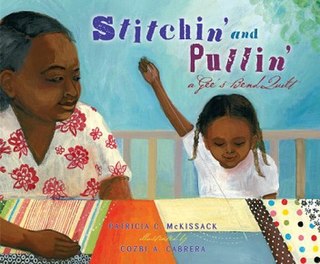 W
WStitchin' and Pullin': A Gee's Bend Quilt is a 2008 picture book by Patricia McKissack and illustrated by Cozbi A. Cabrera. It is about a young girl, Baby girl, who, growing up amongst the quilters of Gee's Bend, Alabama, makes her first quilt.
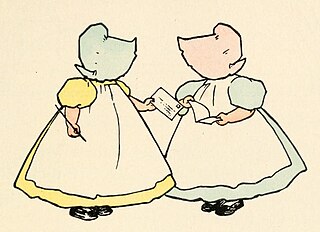 W
WSunbonnet Babies are characters created by commercial artist Bertha Corbett Melcher (1872–1950). Sunbonnet Babies featured two girls in pastel colored dresses with their faces covered by sunbonnets. Sunbonnet Babies appeared in books, illustrations and advertisements between the years of 1900 and 1930. Sunbonnet Babies were later used as a popular quilting pattern also known as Sunbonnet Sue. Melcher created a male version of the Sunbonnet Babies, named the 'Overall Boys' in 1905.
 W
WTivaevae or tivaivai in the Cook Islands, tifaifai in French Polynesia, is a form of artistic quilting traditionally done by Polynesian women. The word literally means "patches", in reference to the pieces of material sewn together. The tivaevae are either made by one woman or can be created in groups of women called vainetini. The vainetini use this time together to bond, sing and catch up on village news.
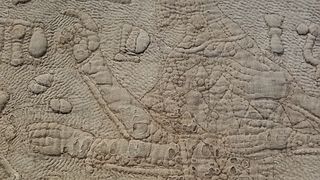 W
WTrapunto, from the Italian for "to quilt," is a method of quilting that is also called "stuffed technique." A puffy, decorative feature, trapunto utilizes at least two layers, the underside of which is slit and padded, producing a raised surface on the quilt.